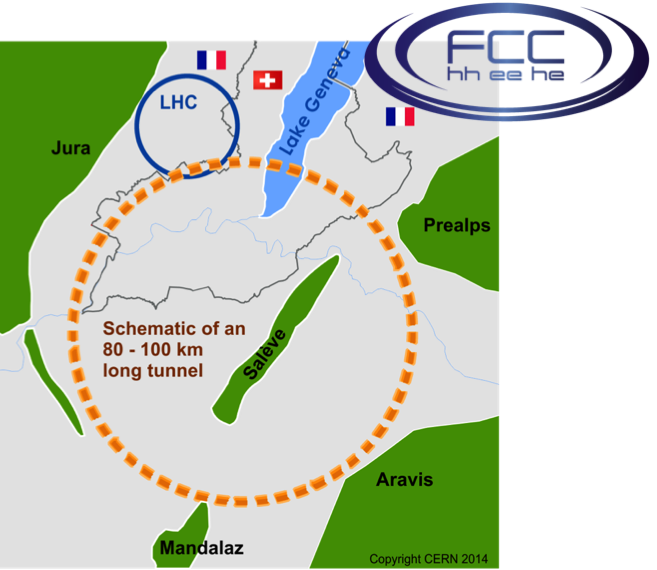- français
- English
Future Circular Collider Working Group
Future Circular Collider study
The discovery of the Higgs boson and a number of experimental results obtained at the Large Hadron Collider (LHC) in the past three years have confirmed the Standard Model well beyond the previously explored energy scale. The next 10 to 20 years will be dedicated to the investigations of the detailed properties of the new particle and searches for clues to the remaining big questions in particle physics.
Luminosity upgrades are expected to increase the LHC integrated luminosity by a factor of 100 (HL-LHC Project), allowing detailed physics studies and will rely on the ability of the LHC to deliver high integrated luminosity while limiting the pile-up (the number of proton-proton collisions per bunch crossing) to what can be handled by the detectors.
While the results from the LHC running at the design energy may shed additional light on some of the outstanding puzzles of the Universe, the data already collected at the LHC has all but eliminated some of the leading contenders for the “final theory”. To glimpse any further clues we will, in all likelihood, require accelerators with energies significantly exceeding that of the LHC, or with sensitivities to much smaller couplings.
Based on the vision formulated in the 2013 update of the European Strategy for Particle Physics, CERN and the international particle physics community have initiated a conceptual design study of options for a future high-energy frontier circular collider at CERN for the post-LHC era. The study addresses a 100 TeV pp collider (FCC-hh) as a long term goal, and a high luminosity e+e- Z,W,H and top factory (FCC-ee, a.k.a. TLEP) as a possible intermediate step, both located in a 100 km tunnel.
The Particle Accelerator Physics Laboratory (LPAP) at EPFL has played a leading role over the last 10 years in the effort to explore the limits of colliders (i.e. the Large Hadron Collider, CLIC, HL-LHC and presently the FCC) with over 30 PhD theses on the most advanced concepts of beam dynamics. Led by Prof Leonid Rivkin, the research activities of the laboratory cover different aspect of accelerator science and technology. An important effort has been put on the study of beam dynamics collective effects: Beam-Beam and Electron Cloud Effects.
Studies of applying machine learning techniques to the collider operation and optimization are part of the team interest. More info here.
These studies are possible thanks to the CHART: the Swiss Collaboration on Accelerator Research and Technology that is based at the Paul Scherrer Institute and unites several Swiss universities and research institutes contributing to the accelerator R&D towards the next world-class project in particle physics.
CHART www.chart.ch
More information about the laboratory activities available at LPAP lpap.epfl.ch
- Ce wiki
- Cette page

